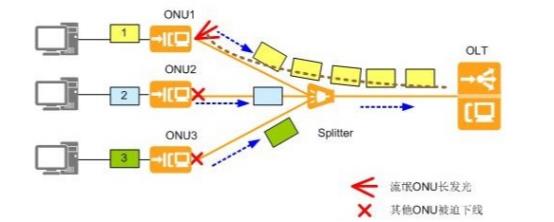The PON system adopts time-division multiplexing technology in the uplink direction, and the ONU sends datagrams to the uplink direction according to the time stamp allocated by the OLT. When an ONU emits light without assigning a time stamp, it will conflict with the emission signals of other onus, which will affect the normal communication of other onus or all onus. The time stamp shows that a rogue ONU does not send optical signals upward. The rogue onus is divided into two types, one is random lighting and the other is long lighting. To ensure the normal operation of the PON system and avoid confusion in the system due to the emergence of rogue onus in the system. Huawei has a function to find rogue ONUs. This is a function in the PON system that looks for terminals that don’t send out light at the right time and then isolates them.
The rogue ONU detection function includes two methods:
1. OLT detection
When the OLT detects a long-emitting ONU, it sends an instruction to isolate the ONU according to the detected ONU. Generally, the OLT detection function is applied to the long-emitting ONU, and there is a certain error in the identification of the random-emitting ONU. By default, the OLT turns off the OLT detection function. At this time, the OLT can detect whether there is a long-emitting onus on the PON line. However, it can only judge whether there are long-emitting onus under the PON port, and cannot locate specific onus. It must locate rogue onus via fiber disconnection on-site.The OLT can identify the specific ONU that emits light under the PON port and can remotely control to turn off the transmission power of the ONU optical module; The precondition is that all ONUs under the PON interface are required to be able to parse the downlink ploam message and respond correctly.
2. ONU bit
When the ONU detects a long light emission, it will automatically isolate it. This function can detect the ONU with long light emission and random light emission.
3. Network management limitations in detecting rogue onus
According to the above principles, the network management needs to meet two conditions when discovering a rogue onus. One is that the detection function has been turned on, and the other is that all onus under the PON port can analyze the downlink ploam message and respond correctly.
Therefore, the network management has a certain probability of discovering and even identifying the equipment information of the rogue ONU for the long-emitting rogue ONU, allowing them to locate the ONU location in combination with the asset management; For a rogue onus that emits light intermittently, there is no good way to find and locate the onus.
The main processing method of the rogue onus is still the step-by-step pull-out test at the optical splitter, so it is very important to update the information on asset management.
The above is the knowledge explanation of “how the rogue ONU came into being” brought to you by Shenzhen HDV photoelectric Technology Co., Ltd. The communication products produced by the company covers;
Module categories: optical fiber modules, Ethernet modules, optical fiber transceiver modules, optical fiber access modules, SSFP optical modules, and SFP optical fibers, etc. ONU category: EPON ONU, AC ONU, optical fiber ONU, CATV ONU, GPON ONU, XPON ONU, etc.
OLT class: OLT switch, GPON OLT, EPON OLT, communication OLT, etc.
The above module products can provide support for different network scenarios. A professional and strong R&D team can help customers with technical issues, and a thoughtful and professional business team can help customers get high-quality services during pre-consultation and post-production work. Welcome you to contact us for any kind of inquiry.






